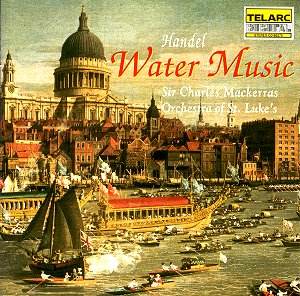For a work as iconic as Handel's 'Water Music', there is a
surprising amount that we do not know about it. Surviving sources are
inconsistent about exactly what went on as the King travelled by barge,
dined and travelled by barge again. We certainly do not know with certainty
which of the music was played, and lacking a surviving score, there are
gaps in our knowledge of the instrumentation. Traditionally, the presence
of trumpets would have implied the addition of timpani. No part survives,
but drum parts were frequently improvised. There is a similar lack of
secure documentation for any harpsichord continuo. What these two instruments
have in common is their unsuitability for the watery stage: damp would
cause havoc with the tuning of both instruments and the harpsichord would
be inaudible from any distance. Tradition also divides the music into
three suites, one in F with horns, one in D major with trumpets and a
chamber suite in G major. But not all of the early sources (mainly arising
from copies produced between 1722 and 1743) agree on the exact arrangement
of movements. This all gives a great deal of scope to the creative editor.
On this recording, Sir Charles Mackerras opts for a
traditional arrangement. There is a harpsichord continuo and there are
no drums, he uses the division into three suites, but sensibly places
the G major chamber suite in the middle between the other, more out-door
suites. Only two movements survive in the composer's hand and these
are F major re-workings of two movements from the D major suite. On
this recording, Sir Charles utilises these two movements to provide
a satisfactory close to the F major suite, though at the first performance
the rather open manner in which the F major suite ends might have been
intentional, providing a neat transition to the next section of music.
The Orchestra of St. Luke's plays on modern instruments,
and it is refreshing to have a new recording that is not on period instruments.
Especially a recording from Sir Charles, who is a past master at eliciting
period inflected performances from modern instrument groups. As might
be expected, he favours brisk speeds and many of the faster movements
are played at tempi comparable to those used on some of the period instrument
recordings. Some of the slower movements are taken at quite leisurely
speeds, but the overall impression is of a welcome briskness, a world
away from the rather more sedate performances by the Academy of St.
Martin in the Fields under Neville Mariner on EMI.
The orchestra plays neatly and stylishly for Sir Charles,
treading a neat line between period style and more modern sensibility.
I was unsure about some elements of the orchestral balance. This is
one of the trickier things to bring off with modern instruments. I felt
that the recorded sound generally favoured the strings and I would have
liked a stronger woodwind sound; doubling the woodwinds would have achieved
a more baroque effect. Similarly the harpsichord sounded undernourished.
The printed sources indicate that by the 1720s a continuo instrument
was envisaged, but surely Handel would not have been happy with the
feeble tinkling that passes for continuo on parts of this recording.
Typical Handelian string texture relies on a strong upper violin line
and a strong bass, with the inner harmony being supported by a strong
continuo, and that does not happen here.
The woodwinds produce an admirably warm sound and perform
their solo passages stylishly. The horns and trumpets are generally
well modulated and betray no sense of strain, but by the end of the
D major suite I did begin to find the trumpets a little too insistent.
The orchestral sound is lean and the performance very
clean limbed with minimum vibrato from the strings. It is a world away
from the lusher string sound of Marriner's Academy of St. Martin's in
the Fields. You only have to compare the opening movements to hear a
radical difference. Not only is Marriner far slower, but his performance
is much more romantic. Understandably, given Mackerras's credentials,
the performance by the Orchestra of St. Luke's has more in common with
recent period instrument performances than with older performances on
modern instruments.
There is discreet ornamentation (notably in the oboe
and flute solos). But sometimes it feels as it the orchestra is on auto-pilot,
though admittedly a rather efficient one. What I missed was fantasy
and vitality, that sense of recreating the music anew at each performance,
something so necessary in this work with its multifarious repeats and
da capo movements.
Not surprisingly, the recording produces no new insights,
but amongst the modern instrument performances of the 'Water Music'
it makes a perfectly good showing. Whilst technically the Orchestra
of St. Luke's may not be quite the match for the Orpheus Chamber Orchestra
on Deustche Gramophon, they do have the advantage of having Sir Charles
Mackerras in charge.
Robert Hugill

